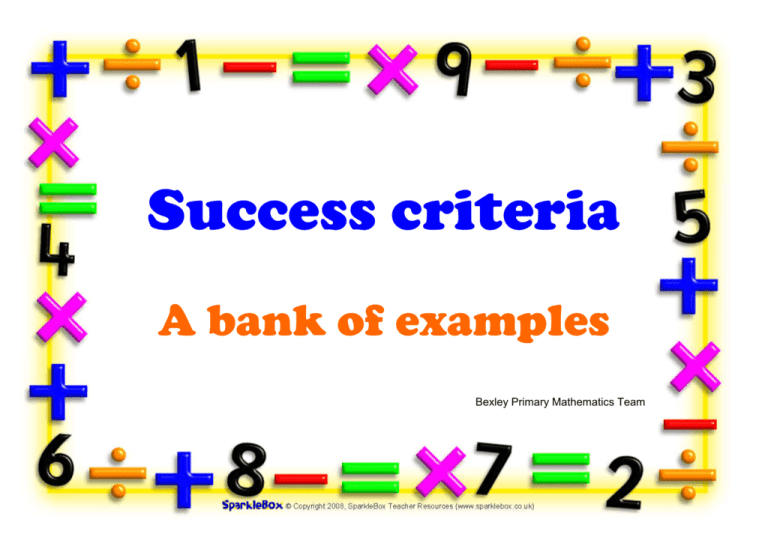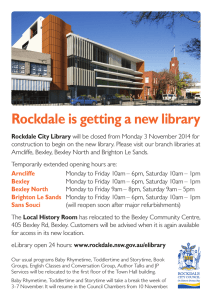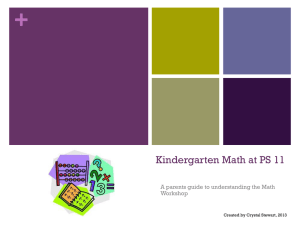Success criteria - bank of examples
advertisement

Success criteria A bank of examples Bexley Primary Mathematics Team Bexley Primary Mathematics Team Reception (Links to Year 1 example) Core learning Count reliably up to 10 everyday objects (Counting and Understanding Number) Learning objective We are learning to count objects reliably Success criteria Remember to… Move each object in turn or touch each object whilst saying the next number (counting) Only count each object once Record the last number you say as that is the number of objects in the set Bexley Primary Mathematics Team Bexley Primary Mathematics Team Reception Core learning Select two groups of objects to make a given total of objects (Knowing and Using Number Facts) Learning objective We are learning to add two numbers together Success criteria Remember to… Count how many objects are in the first group Carry on counting from the last number you said for the first group when counting the second group (don’t start at one again) Check whether the last number you say (total) is the same as the target number (It may be necessary to revisit counting success criteria): Move each object in turn or touch each object whilst saying the next number (counting) Only count each object once Record the last number you say as that is the total number of objects in both groups Bexley Primary Mathematics Team Bexley Primary Mathematics Team Reception Core learning Share objects into equal groups and count how many in each group (Calculating) Learning objective We are learning to share objects equally Success criteria Remember to… Give one object to each of the groups, then another… carry on until you have run out of objects Only give one object to each group at a time Give the same amount of objects to each group Count how many objects are in each group and check they are the same Bexley Primary Mathematics Team Bexley Primary Mathematics Team Year 1 (Links to Reception example) Core learning Count reliably at least 20 objects, recognising that when rearranged the number of objects stays the same; estimate a number of objects that can be checked by counting (Counting and Understanding Number) Learning objective We are learning to count objects reliably Success criteria Remember to… Move each object in turn or touch each object whilst saying the next number (counting) Only count each object once Record the last number you say as that is the number of objects in the set Bexley Primary Mathematics Team Bexley Primary Mathematics Team Year 1 Core learning Read and write numerals from 0 to 20, then beyond; use knowledge of place value to position these numbers on a number track and number line (Counting and Understanding Number) Learning objective We are learning to order numbers Success criteria Remember to… Look at the tens column of the number and decide if the number is less than 10, a ‘tens’ number a ‘twenties’ number… Find where the numbers less than 10, ‘tens’ numbers and ‘twenties’ numbers go on the number line/track/square Look at the units column of the number and make sure that the units column of the number before is less and the units column of the number after is more Bexley Primary Mathematics Team Bexley Primary Mathematics Team Year 1 Core learning Relate addition to counting on; recognise that addition can be done in any order; use practical and informal written methods to support the addition of a one-digit number or a multiple of 10 to a one-digit or two-digit number (Calculating) Learning objective We are learning to add two numbers using an empty number line Success criteria Remember to… Write the biggest number at the beginning of the number line and add on the smallest Add on the tens first then the units by counting on in jumps Draw a loop to show each jump and write the size of the jump above it Write the number you are on after each jump under the line Only add on the amount in the sum (this will be the total above the loops) Bexley Primary Mathematics Team Bexley Primary Mathematics Team Year 1 Core learning Understand subtraction as 'take away' and find a 'difference' by counting up; use practical and informal written methods to support the subtraction of a one-digit number from a one digit or two-digit number and a multiple of 10 from a two-digit number (Calculating) Learning objective We are learning to find a ‘difference’ by counting up Success criteria Remember to… Write the smallest number at the beginning of the number line and the biggest number at the end Count on in jumps until you get to the end number Draw a loop to show each jump and write the size of the jump above it Write the number you are on after each jump under the line Add all the jump amounts together to find the difference Bexley Primary Mathematics Team Bexley Primary Mathematics Team Year 1 Core learning Use vocabulary related to time; order days of the week and months; read the time to the hour and half hour (Measuring) Learning objective We are learning to read the time to the hour and half hour Success criteria Remember to… Look at the big hand to see if the time is o’clock (pointing to the 12) or half past (pointing to the 6) Look at the number the little hand is pointing to, to see what hour it is (e.g. half past 8 or 10 o’clock…) Bexley Primary Mathematics Team Bexley Primary Mathematics Team Year 2 (Links to Year 3 example) Core learning Estimate a number of objects; round two-digit numbers to the nearest 10 (Counting and Understanding Number) Learning objective We are learning to round numbers to the nearest 10 Success criteria Remember to… Look at the digit in the units column – if it is 5 or more then round the number up, 4 or less round the number down. Make the tens number 1 ten bigger when rounding a number up Keep the tens number the same when rounding a number down Check your answer has 0 in the units column (ends in 0) Bexley Primary Mathematics Team Bexley Primary Mathematics Team Year 2 Core learning Represent repeated addition and arrays as multiplication, and sharing and repeated subtraction (grouping) as division; use practical and informal written methods and related vocabulary to support multiplication and division, including calculations with remainders (Calculating) Learning objective We are learning to divide and understand remainders Success criteria Remember to… Give one object to each of the groups, then another… carry on until you can’t give every group another object Only give one object to each group at a time Count how many objects are in each group and check they are the same Count how many objects you have left that you couldn’t share fairly – this is the remainder Check the remainder is less than the number of groups Bexley Primary Mathematics Team Bexley Primary Mathematics Team Year 2 Core learning Estimate, compare and measure lengths, weights and capacities, choosing and using standard units (m, cm, kg, litre) and suitable measuring instruments (Measuring) Learning objective We are learning to measure lengths using cm Success criteria Remember to… Put the 0cm on the ruler at the end of the line to be measured Make sure the ruler is straight against the line to be measured Look at the number on the ruler underneath where the line stops Bexley Primary Mathematics Team Bexley Primary Mathematics Team Year 3 (Links to Year 2 example) Core learning Round two-digit or three-digit numbers to the nearest 10 or 100 and give estimates for their sums and differences (Counting and Understanding Number) Learning objective We are learning to round numbers to the nearest 10 and 100 Success criteria Remember to… Look at the digit in the units column (rounding to 10) or tens column (rounding to 100) – if it is 5 or more then round the number up, 4 or less round the number down. Make the tens number 1 ten bigger or hundreds number 1 hundred bigger when rounding a number up Keep the tens number or hundreds number the same when rounding a number down Check your answer has 0 in the units column (ends in 0) if rounding to the nearest 10 Check your answer has 0 in the tens and units columns (ends in 00) if rounding to the nearest 100 Bexley Primary Mathematics Team Bexley Primary Mathematics Team Year 3 (Links to Year 5 example) Core learning Multiply one-digit and two-digit numbers by 10 or 100, and describe the effect (Calculating) Learning objective We are learning to multiply by 10 and 100 mentally Success criteria Remember to… Move the digits one space to the left when multiplying by 10 Move the digits two spaces to the left when multiplying by 100 Put a 0 in any empty columns to hold the place Bexley Primary Mathematics Team Bexley Primary Mathematics Team Year 3 Core learning Read the time on a 12-hour digital clock and to the nearest 5 minutes on an analogue clock; calculate time intervals and find start or end times for a given time interval (Measuring) Learning objective We are learning to read the time on an analogue clock Success criteria Remember to… Look at the number the little hand is pointing to (or has just gone past) to find out the hour Look at the big hand to see how many minutes past the hour it is Count the little lines round the edge of the clock to find the minutes past (don’t use the numbers in the middle!) Count the minutes in 5s if you are confident Bexley Primary Mathematics Team Bexley Primary Mathematics Team Year 3 Core learning Use Venn diagrams or Carroll diagrams to sort data and objects using more than one criterion (Handling Data) Learning objective We are learning to use a Venn diagram to sort information Success criteria Remember to… Sort the data or objects into the correct group using the criteria Put the data or objects into the overlapping middle section if they belong to both groups Put the data or objects outside the circles if they don’t belong in either group Bexley Primary Mathematics Team Bexley Primary Mathematics Team Year 4 Core learning Develop and use written methods to record, support and explain multiplication and division of two-digit numbers by a one-digit number, including division with remainders (e.g. 15 × 9, 98 ÷ 6) (Calculating) Learning objective We are learning to use the grid method to multiply Success criteria Remember to… Partition the numbers into tens and units, placing one number down the side of the grid and the other along the top Multiply each number down the side with each number along the top, recording the answers in the grid where the numbers meet Find the total of all of the answers in the middle of the grid Bexley Primary Mathematics Team Bexley Primary Mathematics Team Year 4 Core learning Find fractions of numbers, quantities or shapes (e.g. of 30 plums, of a 6 by 4 rectangle) (Calculating) Learning objective We are learning to find fractions of numbers and quantities Success criteria Remember to… Divide the number or quantity by the denominator (bottom number of the fraction) Multiply the answer by the numerator (top number of the fraction) Bexley Primary Mathematics Team Bexley Primary Mathematics Team Year 4 Core learning Know that angles are measured in degrees and that one whole turn is 360 ; compare and order angles less than 180 (Understanding Shape) Learning objective We are learning to compare and name angles Success criteria Remember that… An acute angle is an angle less than 90 An obtuse angle is an angle more than 90 but less than 180 An angle of exactly 90 is a right angle An angle of exactly 180 is a straight line angle Bexley Primary Mathematics Team Bexley Primary Mathematics Team Year 5 Core learning Express a smaller whole number as a fraction of a larger one (e.g. recognise that 5 out of 8 is ); find equivalent fractions (e.g. = , or = 1 ); relate fractions to their decimal representations (Counting and Understanding Number) Learning objective We are learning to find equivalent fractions Success criteria Remember to… Multiply or divide the denominator (bottom number) by the same as the numerator (top number) Convert mixed number fractions to improper fractions or vice versa when comparing Find the decimal representation of the fractions and check they are the same Bexley Primary Mathematics Team Bexley Primary Mathematics Team Year 5 (Links to Year 3 example) Core learning Use understanding of place value to multiply and divide whole numbers and decimals by 10, 100 or 1000 (Calculating) Learning objective We are learning to multiply and divide by 10, 100 and 1000 mentally Success criteria Remember to… Move the digits one place to the left when multiplying by 10, two places when multiplying by 100 or three places when multiplying by 1000 Move the digits one place to the right when dividing by 10, two places when dividing by 100 or three places when dividing by 1000 Put a 0 in any empty columns to hold the place Bexley Primary Mathematics Team Bexley Primary Mathematics Team Year 5 Core learning Refine and use efficient written methods to multiply and divide HTU U, TU TU, U.t U and HTU U (Calculating) Learning objective We are learning to use the ‘chunking’ method to divide Success criteria Remember to… Put the divisor first and the number to be divided (start number) under the bus stop Write how many you have given to each group in brackets and take the total away from start number If you have an amount left that you can’t share out, that is your remainder Record the total given to each group on top of the bus stop (lined up in columns), followed by the remainder if needed Bexley Primary Mathematics Team Bexley Primary Mathematics Team Year 5 Core learning Construct frequency tables, pictograms and bar and line graphs to represent the frequencies of events and changes over time (Handling Data) Learning objective We are learning to draw bar graphs Success criteria Remember to… Select the scale you use carefully Draw equal intervals for the scales on each axis Draw the bars as separate columns up to the appropriate height according to the data (don’t join each bar back to the y axis) Label the axes and give your graph a title to explain what it shows Bexley Primary Mathematics Team Bexley Primary Mathematics Team Year 6 Core learning Express a larger whole number as a fraction of a smaller one (e.g. recognise that 8 slices of a 5-slice pizza represents or 1 pizzas); simplify fractions by cancelling common factors; order a set of fractions by converting them to fractions with a common denominator (Counting and Understanding Number) Learning objective We are learning to simplify fractions by cancelling common factors Success criteria Remember to… Find a number that both the numerator and denominator can be divided exactly by (common factor) Divide the denominator by the same number as the numerator Repeat the process until there are no longer any numbers that both the numerator and denominator can be divided exactly by (the fraction is now in its simplified form) Bexley Primary Mathematics Team Bexley Primary Mathematics Team Year 6 Core learning Estimate angles, and use a protractor to measure and draw them, on their own and in shapes; calculate angles in a triangle or around a point (Understanding Shape) Learning objective We are learning to use a protractor to measure angles Success criteria Remember to… Hold the protractor so that the numbers are the correct way round Put the middle point of the protractor onto the vertex of the angle to be measured Rotate the protractor until a line of the angle is in line with the baseline on the protractor Use the scale (inside or outside) that starts at 0 at the open end of the angle Identify where the second line of the angle sits on the scale Bexley Primary Mathematics Team Bexley Primary Mathematics Team Year 6 Core learning Calculate the perimeter and area of rectilinear shapes; estimate the area of an irregular shape by counting squares (Measuring) Learning objective We are learning to find the area of shapes Success criteria Remember to… Use the formula ‘length x breadth’ for the area of a rectangle and ‘ ½ (length x breadth)’ for the area of a triangle Divide the shape into rectangles and triangles Measure the length and breadth of each divided section Calculate the total of the section areas to find the area of the whole shape Bexley Primary Mathematics Team Bexley Primary Mathematics Team Year 6 Core learning Construct and interpret frequency tables, bar charts with grouped discrete data, and line graphs; interpret pie charts (Handling Data) Learning objective We are learning to interpret pie charts Success criteria Remember to… Identify the size of the data pool (how many the pie chart represents) Find fractions or percentages of the data pool size to interpret the information Check whether the question asks for a number, fraction or percentage as the answer Bexley Primary Mathematics Team Bexley Primary Mathematics Team Year 6 Core learning Describe and interpret results and solutions to problems using the mode, range, median and mean (Handling Data) Learning objective We are learning to find the mode, range, median and mean of data Success criteria Remember to… Calculate the mode by finding the most common value Calculate the range by taking the smallest value from the largest value Calculate the median by writing all of the data in a list from smallest to largest then crossing off one value from each end until you are left with the mid-point (if you are left with two values, the mid-point is the number half way between them). The mid-point is the median Calculate the mean by finding the total of all of the values in the set of data and dividing it by the number of values there are Bexley Primary Mathematics Team Bexley Primary Mathematics Team








